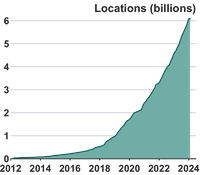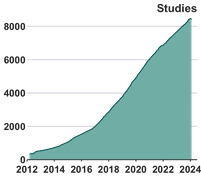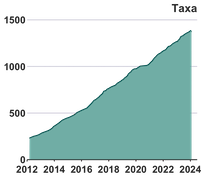February 2024 Newsletter
Dear Movebank users,
We hope this year finds you well, and are excited to bring you updates from Movebank, the global database for animal tracking, including reports of projects led by our partners around the world. As of February 2024, Movebank stores 6.1 billion animal locations and billions more bio-logged sensor measurements managed by thousands of researchers and wildlife managers. These data represent the movements and behavior of over 200,000 animals and 1,383 species. Together, you are adding over 11 million new data records per day, including those from over 22,000 tags streaming through live feeds.
New features & Resources
Here are some of the resources our team and partners have recently added:
- We built live data feeds for Advanced Telemetry Systems (ATS), Africa Wildlife Tracking, G-Matrix Systems, Gundi EarthRanger, ICARUS-TinyFox, ICARUS-WildFi, Savannah Tracking, Sensolus, Smart Parks OpenCollar, Tractive, VECTRONIC Aerospace and Wildlife ACT Innovations. This brings our number of supported data providers to more than 30!
- We expanded our vocabulary to include heart rate and proximity data, as well as descriptions of animal captures and mortalities, family relationships, and sampling and experimental protocols.
- We added hundreds of tips throughout the Movebank web application to guide researchers as they organize their data.
- Our AniMove team has published a suite of lectures on how to prepare and analyze animal tracking and bio-logging data.
- The Firetail team released Version 11 of their visualization and annotation tools for Movebank data and high-end tags to researchers and conservationists.
- The University of Konstanz Communication, Information, Media Centre completed upgrades of the Movebank Data Repository that include versioning of published data packages, more browsing options and an updated API.
- We released open-source software tools for advanced data analysis and archiving, including the R package move2 which offers a renovation of the classic 'move' package. Read more about some of these projects below.
MoveApps
We have been hard at work improving usability, adding features and supporting new contributors to MoveApps, our analysis platform for animal tracking data. The platform now supports over 1,000 users from more than 35 countries and offers 124 open-source modules ("Apps") developed by 20 volunteer coders. With these Apps users can build custom data analysis workflows. You can browse available Apps, read our paper in Movement Ecology introducing the platform, contribute to the MoveApps discussion forum, and publish Apps written in R and Python. Even avid coders are saving time by moving data visualization and preparation steps to MoveApps, taking advantage of the user-friendly interface and options to automate procedures.
Combined with data feeds on Movebank, options to schedule analysis and receive custom notifications at MoveApps offer growing potential to support near-real-time conservation efforts and decision making. We are working closely with wildlife managers as we develop the platform, for example through workshops and collaborations with conservation groups in Africa and as part of the Room2Roam project described below. In cooperation with German wind energy companies, we developed two public workflows for detecting nest sites and flight characteristics during the nesting period, in order to estimate risk of collision with existing and proposed wind turbines. Finally, we were honored to receive a Conservation Technology Award from the Allen Institute for AI's EarthRanger. This award supported our Equip MoveApps for Conservation (EMAC23) coding challenge and workshop, which invited code developers around the world to contribute to MoveApps, focusing on tools to protect African wildlife. Thanks to our growing developer community, we have new collections of apps for continuous-time movement modeling and assessing impacts of human infrastructure on wildlife. Read more.
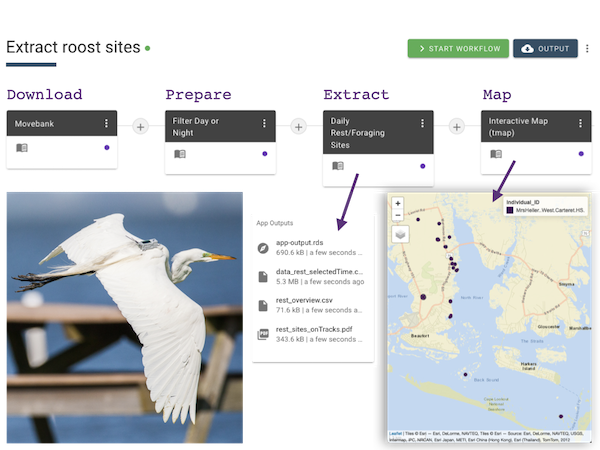
MoveApps workflow to extract nighttime roost sites from tracking data,
Based on the public workflow "4. Roost and Foraging Site Extraction"
(data from study LifeTrack - Great Egrets, photo by Mark Buckler)
Digital life history museum and unique animal identifiers for wildlife
With advancements in methods for tracking animals, researchers are able to monitor more animals for longer and collect a range of multi-media information about individuals throughout their lives. In addition to the sensor recordings themselves, information can come from photographs, text messages and news articles. Further, as more projects are shared and archived, we see a need to be able to recognize individuals across datasets to enable future efforts to bring together data globally. To address these challenges, we have launched the Movebank Life History Museum (MoMu) and Unique Animal Identifier (UAID) system to store accessory files related to tracked wildlife and assign persistent and unique identifiers for animals (Wikelski et al., in review). These advancements will support archiving multi-media, cross-platform data as studies including lifetime tracking and multiple research methods become more common.
Are you running large tracking studies that include extensive photographs or citizen science observations of tracked animals? We encourage interested data managers to start their own timelines of animal lives and assign UAIDs to the wildlife they study. Please visit https://animaltracker.app and to participate in beta testing of these new tools. Read more.
Migration atlases
Since our last newsletter, we were thrilled to see the release of two new migratory bird atlases featuring the work of researchers using Movebank. First, the Eurasian-African Bird Migration Atlas allows visitors to explore movements and connectivity of 300 bird species across 3 continents, using data from bird ringing programs and animal tracking studies. This project is led by the Convention on the Conservation of Migratory Species of Wild Animals (CMS) as part of a broader effort to create a global atlas of animal migration. Read more.
Second, the Bird Migration Explorer offers interactive maps showing bird migrations across the Americas throughout the year, how they connect distant locations across the hemisphere, and where they encounter conservation challenges. The migration maps combine data for nearly 500 bird species from eBird models, bird banding efforts, DNA-based ‘genoscapes’ and animal tracking studies. This project is led by the National Audubon Society and nine partner organizations, including Movebank. Read more.
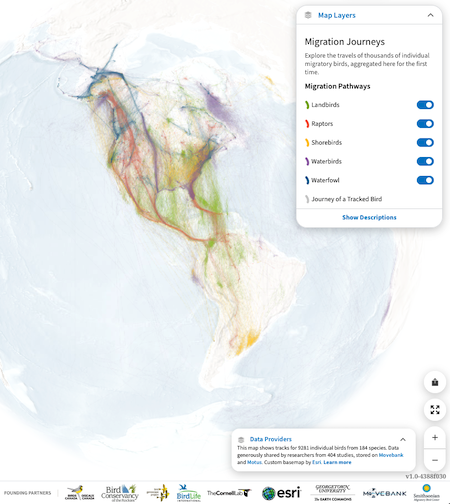
Explore bird migrations tracked across the western hemisphere
with the Bird Migration Explorer from the National Audubon Society and partners.
Applied tools for wildlife management and conservation
With the Room to Roam: Y2Y Wildlife Movements (Room2Roam) project, we are working with wildlife managers and conservation groups to develop open-source tools that support monitoring and conservation programs across an extended Yellowstone-to-Yukon region of western North America. New applications on MoveApps (see above) and ECODATA (see below) include animated maps for exploring data and communicating with stakeholders, resource selection functions to quantify species-habitat associations, and tools to understand the impacts of roads on wildlife movements and identify calving and predation events from tracking data. We held workshops in Whitehorse, Canada and Gardiner, US and launched the Room2Roam Animal Tracking Archive. Support for this project comes from NASA's Ecological Forecasting Program. If you are working in the region and would like to join the project, let us know! Read more.
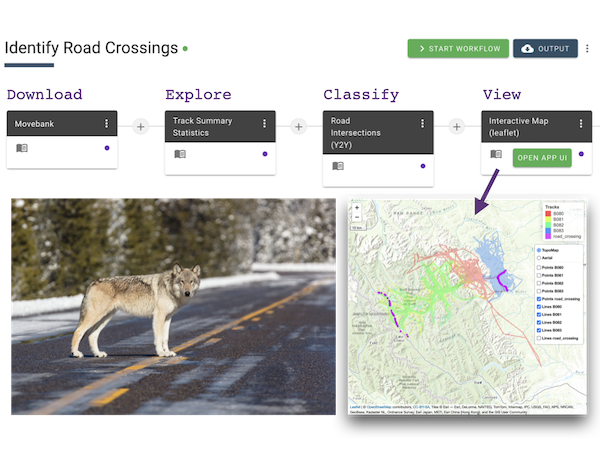
Customizable MoveApps workflow to identify wildlife road crossings from tracking data.
(data from Hebblewhite and Merrill (2011), photo by Jacob W. Frank)
Archiving movement ecology data and methods
Movement ecologists cite nearly 1,100 papers and reports describing their data on Movebank. Nearly 1,000 authors have chosen to formally archive their data in the Movebank Data Repository, which currently contains 325 data packages representing 229 species, over 15,000 individuals and 279 million locations that document research published in 125 journals. Since our last newsletter, we released the following new archiving resources:
First, we have added a second collection to the Movebank Data Repository to archive software and code from MoveApps workflows that have been used in published analyses. This new feature supports reproducible research and provides visibility for those developing cutting edge analysis methods. Read more.
Second, as part of an international collaboration, we helped to develop guidelines to publish animal tracking data as records of biodiversity. The MOVE2GBIF project developed an open-source software package to prepare tracking data in Movebank for publication in the Global Biodiversity Information Facility (GBIF) and Ocean Biodiversity Information Facility (OBIS), and published GPS tracking data for over 200 Eurasian oystercatchers using the new methods. Read more.
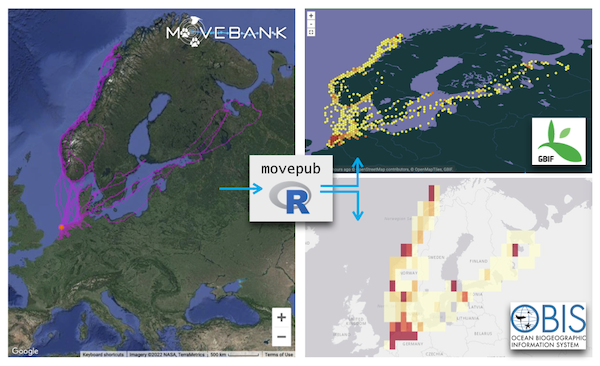
GPS tracks of Eurasian oystercatchers stored on Movebank and published in GBIF and OBIS
(data from van der Kolk et al. (2021))
Connecting animal movements to environmental context
The Env-DATA System on Movebank continues to help researchers assess animal behaviors in the context of their surroundings as documented by hundreds of environmental variables from global remote sensing and weather products. Over the past year, we have updated to newer versions of many products, including variables from MODIS Land, VIIRS Ocean, the ECMWF ERA5 weather reanalysis, ASTER and SRTM digital elevation models, and derived uplift velocity.
To add to this toolset, we released ECODATA, a set of software tools in MATLAB® and Python for creating custom animations of tracking data and preparing remote sensing data for use in resource selection models. Animations can include environmental data layers, shapefiles, labels, elevation contours and more. Read more.
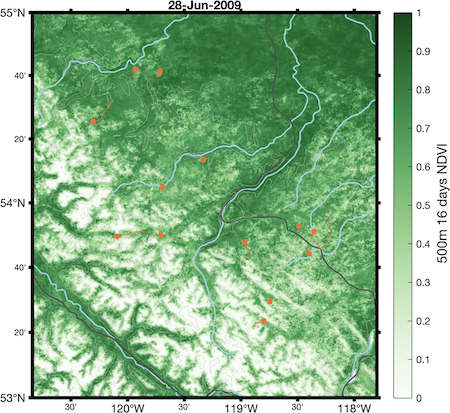
Image from a custom animation of moose movements in southwestern Canada
(tracking data from Peters (2010), vegetation index from NASA product MYD13A1,
elevation contours from the ETOPO1 1 Arc-Minute Global Relief Model, and roads
and rivers from Natural Earth. Watch the video at https://youtu.be/A7reIKCmxZQ.
Conferences and training
We represented Movebank and the projects described above at meetings of the American Geophysical Union, American Ornithological Society, EarthRanger, Ecological Society of America, European Geosciences Union, Global Initiative on Ungulate Migration, iDigBio, International Conference on Ecology and Transportation, WILDLABS and the Wildlife Society, and led workshops with the Wildlife Society and the Y2Y Room2Roam project. We also offer presentations for working groups and organizations. Contact us for resources to introduce Movebank to your network.
Tips for researchers
Want to set up your first study on Movebank, or finish some work you’ve started? Check out these resources:
- Read how to get started with Movebank, whether you want to explore tracking data, organize your own data, or connect with researchers for a new project.
- If your Study Statistics or the map of your tracks don’t look quite right, see our step-by-step instructions and video tutorials on quality control.
- Did you know most data in Movebank are not animal locations, but other sensor measurements? Check out the Attribute Dictionary to see how you could use Movebank to store and share data describing acceleration, conductivity-temperature-depth profiles, heart rate, magnetometry, proximity and more.
- If you get stuck, contact support@movebank.org for assistance.
Are you developing applications that leverage Movebank? Contact us to be listed on our Software page, or consider publishing your work on MoveApps.
What's next?
In addition to the ongoing projects described above, here’s a glimpse of what we'll be working on over the coming year:
- Following our first-ever design and user assessment during 2023, we are preparing a suite of renovations to the Tracking Data Map (supported by the Knobloch Family Foundation).
- We will lead training and networking opportunities, including the 2024 AniMove summer school in Germany and a MoveApps workshop at the annual meeting of the Alaska Chapter of the Wildlife Society.
- We will continue to participate in data archiving and standardization efforts led by the alliance for biodiversity knowledge, the Research Data Alliance, TDWG, the International Bio-Logging Society, WILDLABS and others.
Want to get involved?
- Join our Yellowstone-to-Yukon Room2Roam partnership or the Arctic Animal Movement Archive to cooperate with others working in these regions.
- Connect with the Covid-19 Bio-Logging Initiative, which is coordinating multiple projects exploring the impacts of pandemic lockdowns on wildlife using tracking data. Sign up here to participate or contact covid19.biologging.initiative@gmail.com to learn more.
- We look forward to meeting with users at the 8th International Bio-Logging Science Symposium taking place in Tokyo, Japan in March.
- Connect with us on YouTube, X, Facebook, or send us a message at support@movebank.org.
We are also excited to hear about your own ideas for projects and cooperation! We continue to be amazed by the effort and support from researchers and organizations using Movebank. To stay in touch, find us on Twitter, Facebook, YouTube, or contact us directly at support@movebank.org.
Sincerely,
The Movebank Team

